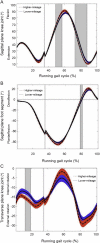Classification of higher- and lower-mileage runners based on running kinematics
- PMID: 31193319
- PMCID: PMC6523820
- DOI: 10.1016/j.jshs.2017.08.003
Classification of higher- and lower-mileage runners based on running kinematics
Abstract
Background: Running-related overuse injuries can result from the combination of extrinsic (e.g., running mileage) and intrinsic risk factors (e.g., biomechanics and gender), but the relationship between these factors is not fully understood. Therefore, the first purpose of this study was to determine whether we could classify higher- and lower-mileage runners according to differences in lower extremity kinematics during the stance and swing phases of running gait. The second purpose was to subgroup the runners by gender and determine whether we could classify higher- and lower-mileage runners in male and female subgroups.
Methods: Participants were allocated to the "higher-mileage" group (≥32 km/week; n = 41 (30 females)) or to the "lower-mileage" group (≤25 km; n = 40 (29 females)). Three-dimensional kinematic data were collected during 60 s of treadmill running at a self-selected speed (2.61 ± 0.23 m/s). A support vector machine classifier identified kinematic differences between higher- and lower-mileage groups based on principal component scores.
Results: Higher- and lower-mileage runners (both genders) could be separated with 92.59% classification accuracy. When subgrouping by gender, higher- and lower-mileage female runners could be separated with 89.83% classification accuracy, and higher- and lower-mileage male runners could be separated with 100% classification accuracy.
Conclusion: These results demonstrate there are distinct kinematic differences between subgroups related to both mileage and gender, and that these factors need to be considered in future research.
Keywords: Biomechanics; Clinical biomechanics; Gait analysis; Kinematics; Motion analysis; Running mileage; Running subgroups.
Figures




References
-
- Saragiotto B.T., Yamato T.P., Lopes A.D. What do recreational runners think about risk factors for running injuries? A descriptive study of their beliefs and opinions. J Orthop Sports Phys Ther. 2014;44:733–738. - PubMed
-
- Hootman J.M., Macera C.A., Ainsworth B.E., Martin M., Addy C.L., Blair S.N. Predictors of lower extremity injury among recreationally active adults. Clin J Sport Med. 2002;12:99–106. - PubMed
LinkOut - more resources
Full Text Sources
Other Literature Sources

